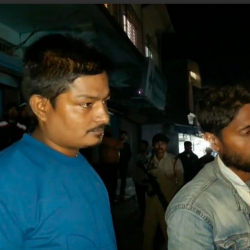The World Health Day this year (7 April 2008) focuses on the need to protect health from the adverse effects of climate change. The theme "protecting health from climate change" puts health at the centre of the global dialogue about climate change. The World Health Organization (WHO) selected this theme for the World Health Day in recognition that climate change is posing ever growing threats to global public health security.
The appalling conditions of health responses during civil unrest, violence and natural calamities like floods in India are well-documented. Also the disease outbreaks, especially water-borne diseases, have been posing an enormous challenge in such situations.
People requiring long-term ongoing care and treatment, are left with hardly any choice to adhere to their drug-regimens during civil unrest or natural calamities. For example people with tuberculosis (TB) who are required to adhere to the anti-TB drugs, often struggle to reach to the TB clinics and the risk to develop anti-TB drug-resistance is enormous. Similarly people living with HIV are struggling to reach to the clinics for the ongoing treatment, care and support services, particularly those who need anti-retroviral drugs and are not able to access them.
Moreover natural calamities escalate the risk of disease transmission and exacerbate the vulnerabilities of people to infectious diseases. With health systems disrupted and healthcare providers often at risk of facing violence themselves, it is a serious concern how to effectively improve health responses during civil unrest, violence and natural calamities.
According to the WHO, "through increased collaboration, the global community will be better prepared to cope with climate-related health challenges worldwide." Examples of such collaborative actions are: strengthening surveillance and control of infectious diseases like tuberculosis (TB), ensuring safer use of diminishing water supplies, and coordinating health action in emergencies.
Overwhelming evidence shows that human activities are affecting the global climate, with serious implications for public health. Catastrophic weather events, variable climates that affect food and water supplies, new patterns of infectious disease outbreaks, and emerging diseases linked to ecosystem changes, are all associated with global warming and pose health risks.
Climate and weather already exert strong influences on health: through deaths in heat waves, and in natural disasters such as floods, as well as influencing patterns of life-threatening vector-borne diseases such as malaria.
Continuing climate change will affect, in profoundly adverse ways, some of the most fundamental determinants of health: food, air and water, according to WHO Director-General Dr Margaret Chan. Malnutrition, lack of access to basic sanitation including access to safe drinking water, and pollution are known factors to aggravate the risk to respiratory diseases including TB.
Areas with weak health infrastructure - mostly in developing countries - will be the least able to cope without assistance to prepare and respond. These impacts will be disproportionately greater in vulnerable populations, which include the very young, elderly, medically infirm, poor and isolated populations.
Increasing global temperatures affect levels and seasonal patterns of both man-made and natural air-borne particles, such as plant pollen, which can trigger asthma. About 300 million people suffer from asthma, and 255 000 people died of the disease in 2005. Asthma deaths are expected to increase by almost 20% in the next 10 years if urgent actions to curb climate change and prepare for its consequences are not taken.
The health impacts of climate change will be difficult to reverse in a few years or decades. Yet, many of these possible impacts can be avoided or controlled. There are established steps in health and related sectors to reduce the exposure to and the effect of changing climate. For example, controlling disease vectors, reducing pollution from transport and efficient land use and water management are well-known and tested measures that can help.
However government of India's response in efficient land use and water management to mitigate the adverse impact of the global climate has been appalling.
The privatization of water, use of agriculture lands as special economic zone for rapid industrialization, heavy displacement of poor people with 'development projects' which put them at grave risk of infectious diseases, are certainly not going to help India in minimizing the harm of the climate change.
The appalling conditions of health responses during civil unrest, violence and natural calamities like floods in India are well-documented. Also the disease outbreaks, especially water-borne diseases, have been posing an enormous challenge in such situations.
People requiring long-term ongoing care and treatment, are left with hardly any choice to adhere to their drug-regimens during civil unrest or natural calamities. For example people with tuberculosis (TB) who are required to adhere to the anti-TB drugs, often struggle to reach to the TB clinics and the risk to develop anti-TB drug-resistance is enormous. Similarly people living with HIV are struggling to reach to the clinics for the ongoing treatment, care and support services, particularly those who need anti-retroviral drugs and are not able to access them.
Moreover natural calamities escalate the risk of disease transmission and exacerbate the vulnerabilities of people to infectious diseases. With health systems disrupted and healthcare providers often at risk of facing violence themselves, it is a serious concern how to effectively improve health responses during civil unrest, violence and natural calamities.
According to the WHO, "through increased collaboration, the global community will be better prepared to cope with climate-related health challenges worldwide." Examples of such collaborative actions are: strengthening surveillance and control of infectious diseases like tuberculosis (TB), ensuring safer use of diminishing water supplies, and coordinating health action in emergencies.
Overwhelming evidence shows that human activities are affecting the global climate, with serious implications for public health. Catastrophic weather events, variable climates that affect food and water supplies, new patterns of infectious disease outbreaks, and emerging diseases linked to ecosystem changes, are all associated with global warming and pose health risks.
Climate and weather already exert strong influences on health: through deaths in heat waves, and in natural disasters such as floods, as well as influencing patterns of life-threatening vector-borne diseases such as malaria.
Continuing climate change will affect, in profoundly adverse ways, some of the most fundamental determinants of health: food, air and water, according to WHO Director-General Dr Margaret Chan. Malnutrition, lack of access to basic sanitation including access to safe drinking water, and pollution are known factors to aggravate the risk to respiratory diseases including TB.
Areas with weak health infrastructure - mostly in developing countries - will be the least able to cope without assistance to prepare and respond. These impacts will be disproportionately greater in vulnerable populations, which include the very young, elderly, medically infirm, poor and isolated populations.
Increasing global temperatures affect levels and seasonal patterns of both man-made and natural air-borne particles, such as plant pollen, which can trigger asthma. About 300 million people suffer from asthma, and 255 000 people died of the disease in 2005. Asthma deaths are expected to increase by almost 20% in the next 10 years if urgent actions to curb climate change and prepare for its consequences are not taken.
The health impacts of climate change will be difficult to reverse in a few years or decades. Yet, many of these possible impacts can be avoided or controlled. There are established steps in health and related sectors to reduce the exposure to and the effect of changing climate. For example, controlling disease vectors, reducing pollution from transport and efficient land use and water management are well-known and tested measures that can help.
However government of India's response in efficient land use and water management to mitigate the adverse impact of the global climate has been appalling.
The privatization of water, use of agriculture lands as special economic zone for rapid industrialization, heavy displacement of poor people with 'development projects' which put them at grave risk of infectious diseases, are certainly not going to help India in minimizing the harm of the climate change.
- 9237 reads









Add new comment